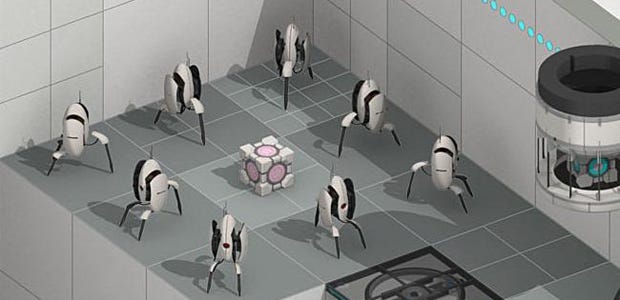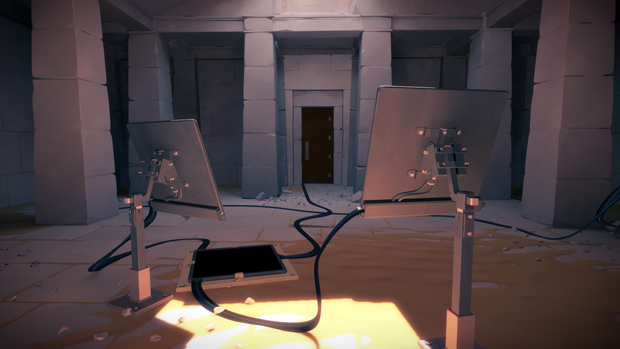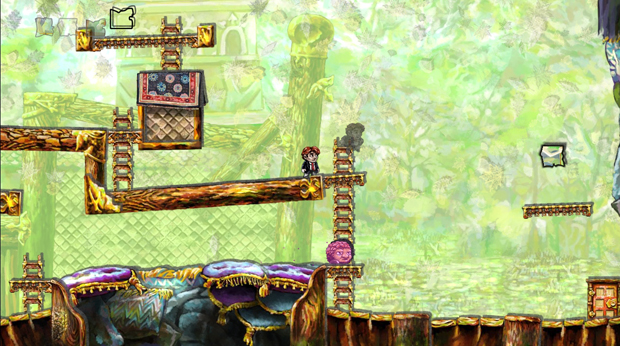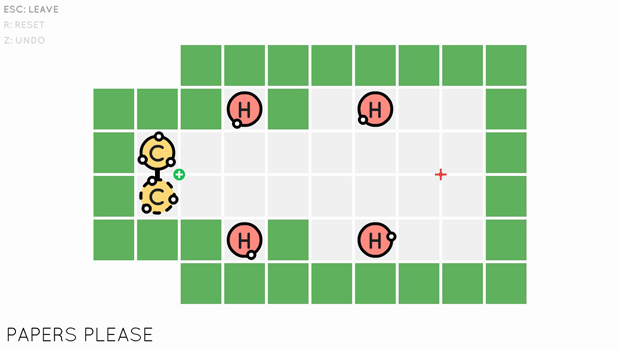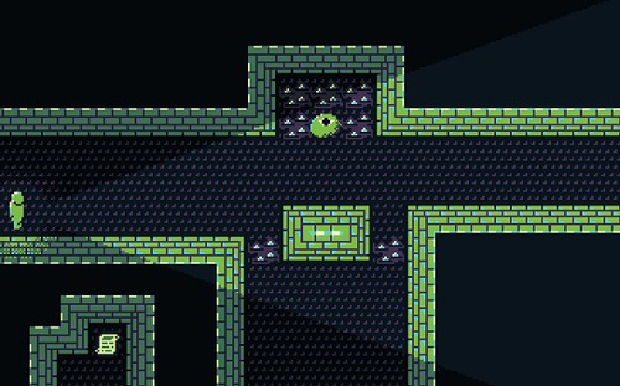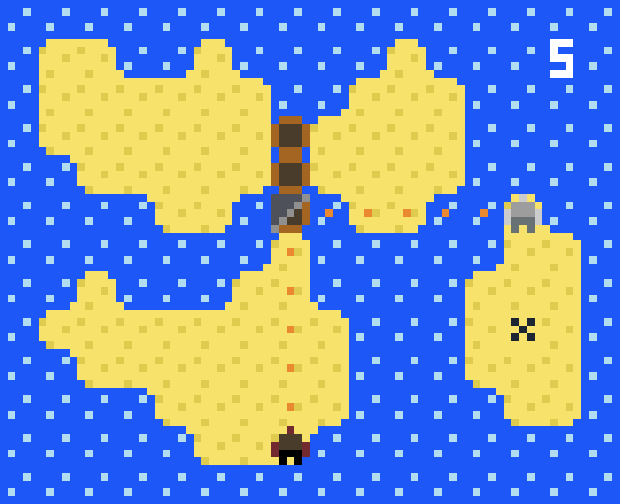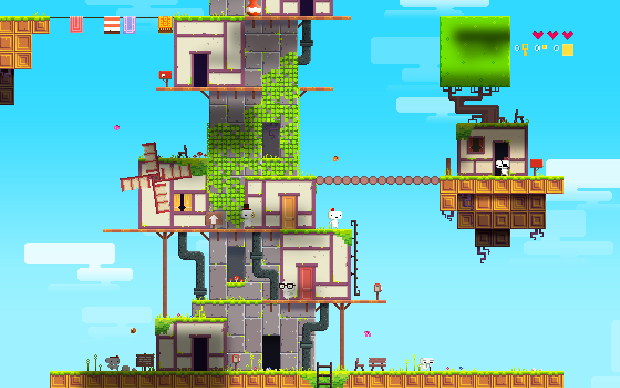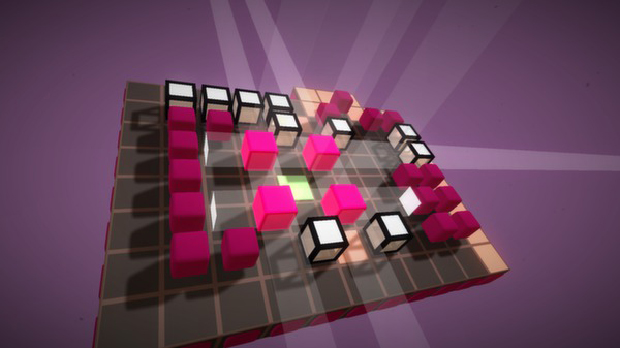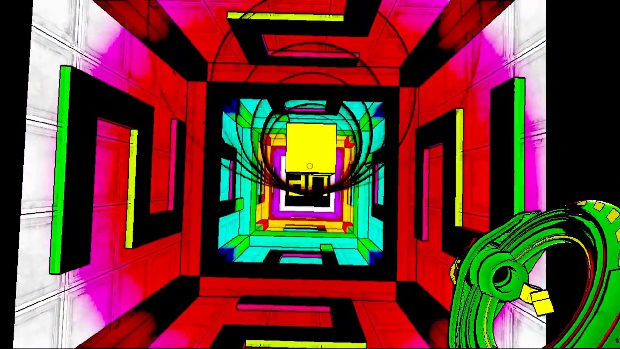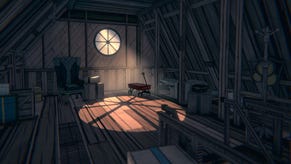A Good Puzzle Game Is Hard To Build
The aesthetics of puzzle game design
I love puzzle games. But it’s not beating them that’s the exciting part: it’s understanding them.
Whether mulling over a cryptic crossword or somersaulting through Portal’s portals, there’s a moment of epiphany which, for me, pretty much transcends all other moments in gaming. But how do you design a puzzle to best provoke that eureka moment? What gives a puzzle its aesthetic, its pace and texture? Why does one puzzle feel thrilling while another feels like a flat mental grind?
I’ve asked three of my favourite puzzle game designers to demystify their dark magicks: Jonathan Blow, best known for the puzzle-platformer Braid and currently hard at work on firstperson perplexathon, The Witness; Alan "Draknek" Hazelden, creator of Sokoban-inspired sequential-logic games, including Sokobond, Mirror Isles and the forthcoming A Good Snowman Is Hard To Build; and Jonathan Whiting, a programmer on Sportsfriends and collaborator with Hazelden on Traal, whose own games are a regular Ludum Dare highlight.
“There are definitely techniques and skill involved,” says Blow. “I’m not completely sure I could lay out for you what those are, because it’s an art, not a science.”
Oh dear. This could be a short article.
But wait! Despite their collective reticence to provide a bullet-pointed recipe for the perfect puzzle, certain topics of conversation return again and again in each interview - ideas like “a good puzzle knows what it’s about”, discussions of minimalism and how that relates to elegance, and how ambition separates a truly great puzzle game from the sort you poke at on your phone while taking a dump. What follows, then, is not a recipe so much as my extrapolated list of possible cooking utensils: approaches to consider which will radically alter the flavour and texture of the resultant concoction.
1. A good puzzle wants to be solved
What’s the difference between a puzzle and a problem? A puzzle is in partnership with the player to reach its own solution - a problem is just an obstacle, impassive and possibly insurmountable. This, I confess, is just my personal theory, and if it’s not broadly true, then it at least applies to the kinds of puzzle games I love - the kind of games that feel like an intimate and inspiring communication from designer to player. As such, a good puzzle provides the player with the tools necessary to solve it; it teaches, and perhaps even coaxes, but ultimately it lets players stand on their own two feet.
And not just the player, says Blow. “I am anthropomorphising puzzles a little bit, which I think is useful. A good puzzle leads the designer to help design the puzzle and often in the process of this happening the designer says, ‘Oh yes, I can reflect some of these same things that I followed and have the puzzle also communicate to the player.’ That’s sort of a separate choice about how cryptic you want the end result to be. I tend to err on the side of not being cryptic.”
“Good puzzles are usually like that,” says Whiting tentatively, before retracting: “Maybe I can’t say that. There’s a category of puzzles that want to be solved, that try and manipulate the player where they haven’t been given the solution but they have some idea of what they should be doing to look for the solution. There’s another class of puzzles that I don’t like so much where there are a lot of elements and one of them is the key one that you have to figure out and then the rest of the puzzle is very simple. A lot of Sokoban levels are like this: there’s a crux somewhere and then the rest of it is rote pushing blocks around.”
An unsolved puzzle is a tree falling in a forest with no one there. What is its purpose if not to be understood, to teach or elevate the player?
2. Learning, rather than solving, is the measure of exhilaration
Elevating the player isn’t just a puzzle’s purpose, though, it’s also its propellant - the difference between a slog and scintillation. What gives a puzzle game a sense of pace is not the beating of its challenges in quick succession, but the speed with which new ideas are presented to you and internalised.
“The flatness [of some puzzles] versus the revelation [of others] - that feels to me the difference between whether you’re being forced to learn things or not,” says Whiting. “When I’m excited playing puzzle games it’s because each new puzzle is forcing me to understand something new about the mechanics of the world I’m taking part in. That’s the exhilaration to me: oh I hadn’t realised I needed to think about that. Designing towards that is a case of breaking down the elements that you could use as those moments, and working out how to introduce those in a way which is neither overwhelming nor so guided that there is no revelation. Flat puzzles, by contrast, don’t have an obvious thing that is being taught.”
I think this explains the difference in texture between puzzle games - but is broadly applicable to any game in which mechanics are learnt and mastered. Puzzle games merely offer this cycle as their explicit purpose, and as such, it becomes all the more obvious when it is absent.
“With things like Sudoku,” says Hazelden, “there are a few advanced techniques, but by and large the approach to solving one puzzle is broadly similar to any other. I don’t really like that style of puzzle game. If you can go through the motions and apply the same sort of thought process and solve every level, then, that can be engaging, but I don’t think it’s very interesting. I try in my games to make different levels feel very different. You can do that with different mechanics, or you can do it by exploring a single mechanic to its full potential. In Sokobond, even within a level pack with the same mechanics, the different levels feel very different because there are different consequences of the mechanics, and exploring a different part of those mechanics means the solution is different and requires you to think differently about it.”
By contrast, many iPhone puzzlers, like Alcazar or 0h h1, quickly introduce the sum total of their puzzle-solving strategies, and then are much the same thereafter, level after level. They offer an acceptable and repeatable diversion during a commute, perhaps, but they don’t offer a sustained trajectory of learning. They are still great puzzles but not great puzzle games - a distinction which suggests the latter has some sort of sustained but self-enclosed journey. But even a great puzzle game like The Talos Principle, whose puzzles do escalate to an extreme level of difficulty, doesn’t necessarily introduce new ideas with the speed required to generate an engaging sense of pace. I found that some of the mechanics were outstaying their welcome during periods when many puzzles in sequence felt like reconfigurations of the same conundrum, without expanding or advancing my understanding.
Compare that to Braid, which illustrates each new idea as succinctly as possible, asks the player to demonstrate their understanding of it, and breezes on and upward. If the game were to then demand you demonstrate your understanding a further three times, the pace would falter. It’s an indicator that simply solving puzzles is not the key to generating pleasure but rather a symptom of the true goal - enlightenment.
3. Making a puzzle is much like solving a puzzle
These aesthetic ideas are all very well, but what are we applying them to? What, when you strip it back, is a puzzle, and how do you start to build one?
We use a lot of analogies to describe games. Sometimes they are a language, with nouns (player, enemy, block, exit) and verbs (walk, kill, push, win). Sometimes they are machines - Whiting talks about the interactions of such nouns and verbs as “mechanics” while Hazelden calls these things tools. Finding the initial set of mechanics that will support an entire puzzle game is tricky: they must be rich enough in possibility to be recombined in new and interesting ways, but they cannot be so complex that they create a chaos from which no singular solution can be intuited.
This process of discovery is very much trial and error for Hazelden. “I make a bunch of small prototypes and play around,” he says. “Then I may realise there’s a lot of scope with one, while others won’t be capable of going much further than the prototype stage.”
Sometimes, games fall in line behind a single gimmick, as Whiting describes with Traal. The inciting notion was that the player loses control of the avatar whenever it spots an enemy. The avatar flees, often into spike pits or other hazards. “The first interaction was built up around that idea,” says Whiting. “That was the very fundamental. Everything else in the game was: what could we do that is interesting given that mechanic is fundamental?”
“The way I construct a level is very exploratory,” says Hazelden. “It’s not dissimilar from the act of solving a puzzle itself. I have some tools that I get to play around with and I have to place them in such a way that it creates an interesting experience. And generally what I do is I lay out some pieces in an aesthetically pleasing fashion and try it and see what comes out of that. The first time is never anything interesting: it’ll be impossible or trivial, but then I’ll react to that and then go, if I add something here then that trivial solution is no longer possible or if I remove that wall then maybe this will become solvable.”
“There’s definitely a large part that is iterative and explorative,” concurs Whiting. “But I would say that I am fairly analytical about the explorations I’m doing. What I’ll typically do first is sit in front of a level editor and jam out a load of things that might be interesting. They may not be puzzles at that stage, but I’m discovering how things interact, working out what my toolset is. Then I’ll write a list of interesting things that this set of mechanics allows me that I might want to teach, and then I’ll collate that list and find some sort of ordering that is implicit in there, or discover that there is no ordering and I can go in any direction I want. And that gives me a starting point for what puzzles should be in the game, and also, when I’m making those puzzles, what is the key part of this that I want to drive home.”
And just what that key part might be often changes during the process of exploration - as Blow describes: “How I know a puzzle is good is when I’m designing it and the ideas that end up in the puzzle are not the ideas that I started with, because it means that I found something that is interesting enough that it leads my standards of what to put in the game.”
But just as is important as that, is deciding what not to put in the game...
4. A good puzzle is elegant and often minimal
“A puzzle should know what the point is, what it’s trying to illustrate to you,” says Blow. “It should know what’s necessary to create that illustration and what’s not, and in most cases it’s best to remove everything that doesn’t contribute to that because you get a smaller, lighter more beautiful thing that becomes more effective.”
An example of how minimalising your design can lead to an elegant game is to be found in Hazelden’s Mirror Isles - a small game that has not an ounce of flab upon it, in which each level accounts for a new thing learned.
“I try to think about the concept of elegance a lot,” says Hazelden. But as to whether that’s the same thing as minimalism, he says: “Not necessarily. It’s related. If a level is bigger than it needs to be then the design should be minimalised to respect the player’s time and boil the puzzle down to the simplest representation of that puzzle. But elegance is slightly harder to pin down. I don’t so much have a definition as a frame of mind when I’m making things.”
Perhaps elegance is not just a lack of irrelevance, but a demonstration of that self-knowledge Blow talks about, of understanding what is to be taught but doing so using the structure of each level and without overtly tutorialising. Blow is a big fan of Mirror Isles and offers this analysis:
“Very early on in that game, you know that the designer knows what he’s doing and that the game’s going to be good,” he says, “It has this focus and clarity and directness. By what route does that happen - that you know it’s a good game? It’s certainly not by the graphics or sound effects. It’s by the level design and from there it starts to become more of an art. What about the level design makes it so clear that this is a game with a strong intent? The levels don’t obfuscate anything. Only the items you need to solve a level are on any particular level. If an item is in a position to help you or block you - it’s not extraneous; you need that to solve the level, or it’s required to pose the proper challenge. The shape of the islands matter a lot. Like: oh, that peninsula sticks out by two squares, maybe I’m supposed to get into range of that thing."
“A corollary to that is that the game is at the right scale,” Blow continues. “You could imagine that increasing the resolution of the grid to five times what it is, and suddenly it would be a lot more annoying to play. Right now, you have a certain range of how far you’re going to bounce off the mirror based on your distance to it and it’s a small countable number. It’s [normally] between one and eight, right? Imagine if that was between one and four hundred and you needed to get between 370 and 275 to solve a puzzle, that would be really annoying and stupid because it introduces a fiddliness that doesn’t have anything to do with the clarity of the core concept, and by distilling it down to a small grid with a small number of things you can figure out the minimum you need to make the right experience.”
But there are counterarguments to be made. Blow suggests there are times when a laser-focus can be traded for a broader intent. We talk about Fez - a game we both love - which externalises many of its puzzles to a meta layer of cryptography, separate from the platforming challenge of the world.
“That’s one of the things that makes it a game I wouldn’t have designed,” says Blow. “The games I’ve been doing lately are focussed around a central idea and then everything contributes to that. In my version of Fez, every single thing in the game would have been about collapsing 3D to 2D by rotating the levels. However - that’s a certain kind of design - concentration and focus on one idea. Fez is a different thing. Fez is about building a sprawling world that has this idea at the centre, but it allows itself to go out from that and add things to the world. That’s not necessarily bad!
“There are dangers to that - you can end making something really confusing or incoherent, or you can end up not even really exploring the core idea at all because you’re busy with these other things. But there are benefits to it too. There’s a certain feeling you can get when you’re building a sprawling big thing that you don’t really get with a small thing. The Witness is a bit like that, too. Braid was small and focussed on specific ideas: you can think of everything that happens as things arranged and pointed at the centre. In The Witness you’ve got things arranged around the centre because they are all relevant to the core idea but they aren’t all necessarily pointing at the centre, but off to the side somewhere, saying, ‘Oh, you know, you can draw an interesting observation between the core mechanic we’re talking about and this other thing that has nothing to do with it.’
Elegance, focus, minimalism - these are the tools by which the designer can channel their intent, to better stimulate that vital epiphany in the player. But they are also things that can be traded for a larger purpose. Perhaps Fez is allowed such leeway with its design because it’s a game which encourages the player to luxuriate in the experience of playing it. Just being in that environment is joyous - a sensation that is the culmination of the game’s aesthetic choices, from the rhythm of your avatar’s movement and the scale of its overall structure, down to the palette and ambience of any given environment. Its achievement as a puzzle game is not just about the puzzle elements themselves - it has something to say, about the medium in which it exists and the nostalgia we feel for it. “You can feel that ambition to build something beautiful,” says Blow. “That shines through on the level of the whole game.”
5. Ambition elevates all
“All that I was saying, about streamlining a puzzle and making sure the puzzle knows what it is - all that is true,” says Blow. “But there’s another layer on top of that which is something about the ambition of the structure of the whole game. What are you trying to make in the first place? Are you trying to make a tour de force of puzzles that are really amazing and have something interesting to say, or are you executing the tried and true form of a puzzle game and filling in the blanks. And that latter thing is what people usually do when they design most games. If you do that with a puzzle game it’s probably not very good.”
Perhaps puzzle games, which, more so than other genres, are explicitly about progressively enlarging a player’s understanding, are well placed to deliver experiences which really inspire profound thought. Certainly The Talos Principle tries, framing its puzzles as a test of sentience, and, externally to those, discussing in some considerable depth notions of humanity, dualism and morality.
Of course, you don’t need to deliver a primer in Cartesian ontology along with your puzzles - but the puzzles will benefit from having a plan of escalation which exceeds the mere consumption of the player’s time. Where is it all going? What can you hope to use these puzzles to teach? One of the most brilliant and ruthlessly opaque puzzle games, English Country Tune, starts as a Sokoban-style block puzzle, but then spins off with alarming rapidity, eventually requiring you to use an editor to build the puzzle level which will then allow you to solve it under certain preconditions. That contortion, forcing the player to transcend from puzzle solver to puzzle creator - yet still within the context of a larger puzzle - feels like suddenly discovering you are in fact the innermost of a nested set of Matryoshka dolls.
Its creator, Stephen Lavelle, is working on a new game, Sausage Roll, which is widely tipped by those who’ve played it as a contender for the best puzzle game of all time. Again, as Blow says, “It’s one of those games that has a large ambition. It doesn’t stop coming, and it goes way beyond where you would have expected would have been fine if it’d only done that. It’s also probably an acquired taste for people who like videogame puzzles. I’m not saying that’s a fault of the game - in fact it's the opposite. Some of the places the game goes that contribute to the game being so good, it only is allowed to go there because it’s allowing itself to be a little bit player-unfriendly.”
Ambition can rescue a game in which the puzzles otherwise betray the principles of good design. Blow points to the curious example of Antichamber, a game which I feel has a somewhat erratic quality control.
“Antichamber is really interesting because Alexander Bruce was working on that game for a long time, like five or six years,” says Blow. “His skills as a game designer evolved tremendously over that time; that’s how he learned game design, by making that game. And the game was very different at the beginning of development than it was at the end. A lot of the stuff from the beginning of development was cut, but a lot of it is still there. The game just organically grew. Some of the things in the game use these aesthetics of puzzle design and some of them don’t. Some of them are just weird and arbitrary - and those are the things that happened more toward the beginning of development. But you can feel the ambition of the game as a whole, and that’s a little bit exciting. It’s not trying to be, “Oh here are some puzzles, why don't you solve them?” it’s trying to do something really cool. Some of the puzzles hit that target better than others, but it’s educational I think, in that it illustrates that not every part of the game needs to be built with a certain eye or specific technique.”
Ambition as mitigation, then. Of course, it doesn’t come easily - but then the things most worth doing are often the hardest. And there can be few things harder than making a good puzzle game. We players may think they’re tough to crack, but the folks making them are reverse engineering a car while trying to test-drive it along the track. And yet the reward is a game that thinks so closely about player reactions and expectations that it can create in them a sense of spontaneous realisation, it can make them discover, with great delight, something entirely new about the world. This leads us to perhaps the most delightful revelation of all: that such joy is not born of nothing, but secretly a gift, made with care, just for us.
This article was made possible by the RPS Supporter Program.
